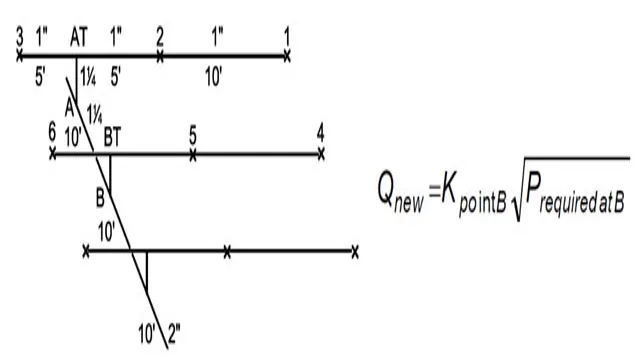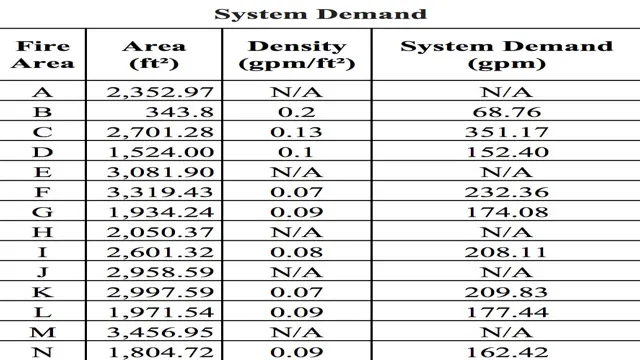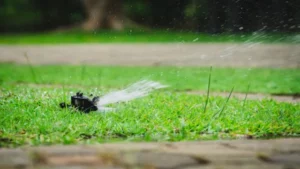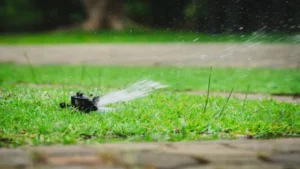Sprinkler systems are essential for ensuring that yards, gardens and lawns remain green and healthy. However, many wonder about the average flow rate for a sprinkler system. It’s an understandable inquiry, given that the correct flow rate is crucial for maintaining optimal coverage and efficient use of water.
In this blog, we’ll dig deep into what the average flow rate for a sprinkler system is, how it’s calculated, and what factors are considered in determining the flow rate. By the end of this blog, you’ll have a clear idea of how to calculate your sprinkler system’s flow rate and ensure that your garden and lawn receive the care they need to thrive. So, let’s get started!
Understanding Flow Rate
When it comes to sprinkler systems, understanding flow rate is important for ensuring efficient water usage and avoiding potential damage to the system. The average flow rate for a sprinkler system can vary depending on the size and type of the system, as well as the water pressure available. Generally, residential systems have a flow rate of around 5-10 gallons per minute, while commercial systems can have much higher flow rates.
It’s important to accurately calculate the flow rate of your system in order to properly design and install it, as well as to maintain it over time. This can be done with the use of flow meters or pressure gauges, or by consulting a professional sprinkler system installer or technician. Properly understanding and managing flow rate can ultimately help save water and money, while also ensuring a healthy and vibrant landscape.
What is flow rate?
Flow rate is simply defined as the amount of fluid that passes through a specific point within a given period. It can be used to describe the flow of liquids such as water, oil, and gas or even gases such as air. Flow rate is an incredibly important concept that is used in various fields such as engineering, chemistry, physics, and medicine.
For instance, in the field of engineering, flow rate is used to determine the size of pipes to ensure that the flow is neither too slow nor too fast. In the field of medicine, flow rate is used in the administration of intravenous fluids to patients. It is important to note that flow rate is affected by various factors including the viscosity of the fluid, the diameter of the pipe, the pressure and the temperature of the fluid.
Therefore, understanding flow rate is crucial in ensuring the optimal functioning of various systems.

Why is it important for sprinkler systems?
When it comes to fire prevention, sprinkler systems are crucial. And understanding flow rate is a critical aspect of making sure these systems work properly. Flow rate refers to the amount of water that exits a fire sprinkler system per minute.
This rate is essential because it determines how much water is available to suppress a fire in case of an emergency. If the flow rate is too low, the sprinklers won’t release enough water, and the fire can continue to grow. On the other hand, if the flow rate is too high, it can damage the building and its contents.
Therefore, it’s important to have the correct flow rate to ensure proper fire protection. Regular maintenance and inspections of sprinkler systems can help ensure the flow rate is within acceptable parameters. By doing so, building owners and managers can rest assured that their sprinkler systems are functioning correctly and providing adequate fire protection.
Factors Affecting Flow Rate for Sprinkler Systems
When it comes to sprinkler systems, the average flow rate can vary based on a few different factors. One of the biggest factors is the size of the pipes in the system. If the pipes are smaller, the flow rate will be slower, and vice versa.
Another important factor is the pressure involved in the system. If there is high pressure, the flow rate will be faster, but if there is lower pressure, it will be slower. The water source itself can also affect the flow rate, as it may have varying levels of pressure and volume.
Finally, the type of sprinkler heads being used can also play a role in the flow rate, as some types are designed for higher volume output than others. Overall, the flow rate for a sprinkler system will depend on the specific characteristics of the system, and will likely need to be calculated based on those factors.
Water pressure
Water pressure When it comes to sprinkler systems, proper water pressure is crucial for ensuring adequate flow rates. Several factors can affect the flow rate of a sprinkler system, including the size of the pipes, the number and type of sprinkler heads, and the elevation of the system. Additionally, water pressure can be affected by the distance between the sprinkler system and the water source.
Generally, the closer the system is to the source, the higher the water pressure will be. Other factors that can impact water pressure include the time of day, the temperature of the water, and the presence of air bubbles or debris in the pipes. Typically, sprinkler systems require a water pressure of at least 30 PSI to function properly, but some systems may require higher levels depending on their specific design.
It’s essential to understand these factors to ensure the optimal performance of your sprinkler system and maintain a lush, healthy lawn.
Nozzle size and type
When it comes to sprinkler systems, the nozzle size and type play a significant role in the flow rate. The nozzle size is the opening at the end of the sprinkler’s arm that allows water to spray out. Increasing the nozzle size will increase the flow rate, while a smaller size will decrease it.
Additionally, the type of nozzle can affect the flow rate, with some dispersing water in a wider pattern and others in a more concentrated pattern. It’s essential to choose the right nozzle size and type for your specific needs to ensure adequate water coverage. For example, a larger nozzle may be better suited for watering a large lawn, while a smaller nozzle may work better for a garden bed.
Keep in mind that nozzle sizes and types can be adjusted to modify flow rates, allowing for greater flexibility in your sprinkler system.
Sprinkler head spacing
Sprinkler head spacing When it comes to sprinkler systems, the flow rate is an essential factor to consider. The spacing of the sprinkler heads, for instance, can affect the flow rate as well as the overall performance of the system. Ideally, you should space the sprinkler heads in a way that ensures full coverage and efficient water distribution.
If the spacing is too close, the water spray may overlap, resulting in over-watering or water wastage. On the other hand, if the spacing is too far, there may be dry areas within the coverage zone, which can also affect the flow rate. As a general rule, the ideal spacing between sprinkler heads is no more than 18-20 feet, depending on the type of sprinkler head and the water pressure available.
Proper spacing ensures that each head has enough water to distribute and that the whole area is adequately covered. So, before installing a sprinkler system, consider the recommended sprinkler head spacing for optimal performance and water efficiency.
Pipe size and length
When designing a sprinkler system, the pipe size and length are important factors to consider to ensure proper flow rate. The larger the diameter of the pipe, the more water it can carry, resulting in higher flow rates. However, longer pipe lengths can lead to a decrease in flow rate due to friction loss, which occurs as the water moves through the pipe and experiences resistance from the pipe walls.
It’s essential to find the right balance between pipe size and length to achieve optimal flow rate for the system. Think of it like trying to fill a large bucket of water with a small hose. It may take longer due to the limited flow rate of the hose.
But if the hose is too long, the water may not reach the bucket at all due to loss of pressure and friction. So, when designing a sprinkler system, it’s crucial to consider the pipe diameter and length to ensure a consistent and effective flow of water to all areas of the target space.
Calculating Average Flow Rate
If you’re wondering what is the average flow rate for a sprinkler system, it really depends on a few factors. Firstly, you’ll need to determine the water pressure of your system in pounds per square inch (PSI) using a pressure gauge. The second factor you’ll need to consider is the size of the water meter.
Once you have these measurements, you can use an equation to calculate the flow rate. Make sure you take into account the number of sprinkler heads, as each one will contribute to the overall flow rate. Generally, the recommended flow rate for a sprinkler system is 1-2 gallons per minute per sprinkler head.
However, it’s important to note that the average flow rate can vary depending on the type of sprinkler head, the shape and size of the area being watered, and the type of plants or grass being watered.
Step 1: Measure water pressure
Measuring water pressure is the first step to calculate the average flow rate of your water system. Water pressure can fluctuate due to various factors, including changes in demand, flawed plumbing fixtures, or obstruction in the pipes. Using a pressure gauge, you can measure the water pressure in PSI (pounds per square inch), which helps you understand the water flow.
After measuring the pressure, you can calculate the average flow rate, which is the amount of water that flows through your pipes in a given time. The average flow rate is measured in gallons per minute (GPM) and is essential to understand for sizing and selecting different plumbing fixtures and appliances such as showerheads, faucets, and water heaters. By determining the average flow rate, you can ensure that you have adequate water pressure and volume for your daily water needs.
Step 2: Determine nozzle size and type
Calculating the average flow rate of a nozzle is crucial in determining its size and type. This process involves measuring the quantity of water that flows through the nozzle over a certain period. To calculate the average flow rate, you will need a container, a stopwatch, and accurate measurement tools.
Fill the container with water from the source intended for the nozzle and ensure that the container and the water inside are at room temperature. With the stopwatch set, turn on the water flow and collect the water in the container for a specified time. Stop the stopwatch and measure the amount of water collected accurately.
Divide the quantity of water collected by the time taken, and you will determine the average flow rate of your nozzle. This calculation will aid in determining the nozzle size and type suitable for your needs.
Step 3: Calculate sprinkler head spacing
Calculating the average flow rate is a crucial step in determining the sprinkler head spacing for your lawn. The flow rate is the amount of water that flows through the pipe per minute, and it varies depending on the size and material of the pipe, water pressure, and the height of your lawn. To calculate the flow rate, you need to divide the water pressure by a friction loss factor, which will give you the GPM (Gallons per Minute) for the pipe.
You can then calculate the total GPM for all the sprinkler heads you plan to install by multiplying the GPM of one head by the number of heads you have. This will give you the total flow rate you need to design your system. Calculating the average flow rate is important because it helps you determine the right size and spacing for your sprinkler heads, ensuring even distribution of water across your lawn.
Step 4: Measure pipe size and length
Calculating the average flow rate of a pipe is a crucial step in measuring its size and length. There are different methods to calculate the flow rate, but the most common one is using the volumetric flow rate formula. This formula requires measuring the volume of fluid that passes through the pipe per unit of time.
For instance, if a pipe conducts water at a rate of 1 liter per second, then the volumetric flow rate equals 1 liter per second. Once you have the volumetric flow rate, you can multiply it by the fluid’s density to obtain the mass flow rate, which is in units of mass per unit of time. Ultimately, knowing the flow rate helps choose the appropriate pipe size and length that meet the requirements of the system.
Overall, calculating the average flow rate is an essential part of measuring pipe size and length and is an essential step in determining the efficiency of the system.
What is the Average Flow Rate for a Sprinkler System?
If you want to know the average flow rate for a sprinkler system, it really depends on the size of the system you’re using. Typically, residential systems have a flow rate of around 5-10 gallons per minute (GPM). On the other hand, commercial and large-scale irrigation systems can have flow rates that range from 20 to 200 GPM.
It’s worth noting that sprinkler systems often need to meet municipal codes and regulations, which may impact the flow rate. Additionally, factors like water pressure, the number of sprinkler heads, and the spacing between them all play a role in determining a sprinkler system’s flow rate. If you’re unsure about the appropriate flow rate for your particular setup, it’s always best to consult with a professional irrigation consultant.
Residential sprinkler systems
Residential sprinkler systems, Average Flow Rate, Sprinkler System If you are considering installing a residential sprinkler system, it is important to know the average flow rate for such a system. The flow rate indicates how much water the sprinkler system can deliver in a given time period, typically measured in gallons per minute (GPM). The average flow rate for a residential sprinkler system is around 12-18 GPM.
However, this can vary depending on the size of the system and the water pressure available. It is important to have a professional assess your property to determine the best system size and flow rate for your needs. Keep in mind that having too high of a flow rate can actually cause damage to your property, so it is crucial to find the right balance.
Overall, investing in a residential sprinkler system can provide peace of mind and protection for your home and loved ones.
Commercial sprinkler systems
When it comes to commercial sprinkler systems, the average flow rate can vary depending on various factors such as the size of the building and the number of sprinkler heads installed. The flow rate is essentially the amount of water that flows through the system in one minute, and it’s measured in gallons per minute (GPM). However, an approximate estimate for a commercial sprinkler system is around 150-300 GPM.
It’s essential to keep in mind that the flow rate should be sufficient to cover all the areas that need protection and also meet the local fire codes. Therefore, it’s crucial to consult with professionals who have expertise in designing and installing sprinkler systems to ensure that the flow rate and water pressure are adequate. With the correct flow rate, the sprinkler system can effectively put out any flame in the building and provide maximum safety to its occupants.
So, when installing a commercial sprinkler system, always remember to consider the flow rate as a crucial factor to ensure optimal protection and compliance with local fire codes.
Conclusion
In conclusion, determining the average flow rate for a sprinkler system is no easy task. It requires taking into account variables such as water pressure, pipe diameter, and nozzle type. But fear not, for with a little math and some sprinkler know-how, you too can calculate the perfect flow rate for your garden oasis.
So, let the water flow and your lawn flourish with the perfect amount of moisture. Ain’t no sprinkler gonna rain on your parade now!”
FAQs
How do I calculate the average flow rate for my sprinkler system?
To calculate the average flow rate, you need to measure the amount of water your sprinkler system uses in a given time period and divide it by the total area covered by the sprinklers.
What factors can affect the average flow rate of a sprinkler system?
The average flow rate of a sprinkler system can be affected by various factors such as water pressure, nozzle size, pipe diameter, terrain, and weather conditions.
Can the average flow rate of a sprinkler system be increased?
Yes, the average flow rate of a sprinkler system can be increased by optimizing the system components such as increasing water pressure, installing larger nozzles, or upgrading the pipe diameter.
How often should I check the average flow rate of my sprinkler system?
It is recommended to check the average flow rate of your sprinkler system at least once a year to ensure it is working efficiently.
What is the maximum flow rate for a residential sprinkler system?
The maximum flow rate for a residential sprinkler system is typically around 25 gallons per minute.
Can a low average flow rate damage my sprinkler system?
Yes, a low average flow rate can cause damage to your sprinkler system by increasing the risk of clogged nozzles or leaking pipes.
How can I improve the average flow rate of my sprinkler system without increasing my water bill?
You can improve the average flow rate of your sprinkler system without increasing your water bill by following proper system maintenance, upgrading to water-efficient nozzles, and incorporating drought-resistant plants in your landscape design.






